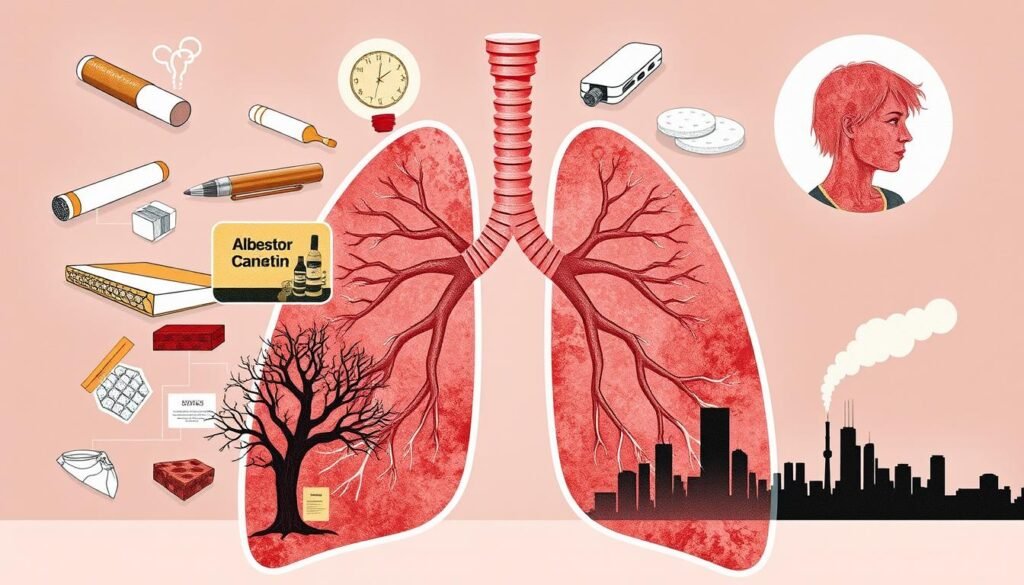Did you know about finger clubbing? It’s seen in about 35 percent of those with non-small cell lung cancer. This fact shows how important it is to spot signs early. Catching cancer early can really change how well treatments work. So, learning about and using the thumb test for lung cancer is key. It’s a simple way to check your risk and stay on top of your health.
Key Takeaways
- The thumb test for lung cancer is a straightforward method for early detection.
- Awareness of lung cancer symptoms is crucial for timely intervention.
- Finger clubbing can be an indicator of lung cancer, seen in 35% of non-small cell lung cancer cases.
- Regular respiratory health monitoring can aid in recognizing concerning signs.
- Consulting with a healthcare professional is essential if symptoms arise.
Understanding Lung Cancer Symptoms
Knowing lung cancer symptoms is key to early detection and improving health. Many are not aware of these signs. Being able to spot them means you can seek help early. This is vital for effective treatment and awareness.
Common Signs of Lung Cancer
Some common lung cancer symptoms are:
- A persistent cough lasting three weeks or more
- Shortness of breath or breathlessness
- Unexpected weight loss
- Chest pain or discomfort
- Fatigue or weakness
Spotting these early can make a big difference in treatment success. Specifically, early signs like finger clubbing matter a lot. Around 35% of those with non-small cell lung cancer show this.
Importance of Recognizing Symptoms Early
Identifying early symptoms such as a lingering cough and sudden weight loss helps assess cancer risk. Early detection means better survival chances. Quick action is critical for effective treatment and making health changes.
The Thumb Test for Lung Cancer: An Overview
The thumb test is an easy self-check for lung health. It alerts you to possible lung issues, like cancer. Knowing how to do this test helps catch symptoms early, leading to quicker help from doctors.
What is the Thumb Test?
The thumb test, also known as the Schamroth window test, checks for signs of health problems. You do it by pressing your index finger nails together to see if there’s a diamond gap. No gap could mean finger clubbing, which is linked to lung problems, including cancer.
How the Thumb Test Works
This test is a simple way to keep an eye on your health. If you don’t see the diamond gap, it might mean you should look into it more. It’s not a final diagnosis but can push you to get checked by a doctor sooner for lung issues.
What is Finger Clubbing?
Finger clubbing means your fingers and nails get bigger and curve. It shows there might be health problems, mainly with the lungs. It’s common in people with certain diseases, like lung cancer. Spotting it early can help get the right treatment fast.
Identifying the Symptoms of Finger Clubbing
It’s important to know the symptoms of finger clubbing. It starts with the nail bed getting soft. Then, the shape of the fingernail changes. You might see:
- Swelling at the fingertips.
- An increase in the angle of the nail bed, known as the Lovibond angle.
- Thickened or rounded appearance of the nails.
This can happen quickly, in just weeks. Treating the main cause, like lung cancer, can really help.
Connection Between Finger Clubbing and Lung Cancer
About 35% of people with non-small cell lung cancer have finger clubbing. Clubbing can mean there’s not enough oxygen in the blood. This might be from heart or lung diseases. Knowing the signs of clubbing is helpful. If you see these signs, you should consult a healthcare professional. It might be something serious.

How to Perform the Thumb Test for Lung Cancer
Learning how to do the thumb mobility test is a key step in spotting lung cancer signs early. This easy test helps people look for finger clubbing, a possible early sign of lung cancer. Knowing this test lets people keep an eye on their lung health and get medical advice when needed.
Step-by-Step Guide to the Test
- Start by placing the nails of both index fingers together, ensuring they are facing each other.
- Observe the area between the nails. A healthy thumb mobility test will result in a diamond-shaped gap of light appearing between them.
- Take note of any absence of this gap, as it could indicate finger clubbing.
What to Look For During the Test
When you do the thumb mobility test, look for a space between the nails. A missing gap might mean the nail beds have changed shape, which is linked to lung cancer. Seeing this change is a reason to get checked by a doctor, especially since catching it early can really help with treatment.

| Observation | Indicator |
|---|---|
| Diamond-shaped gap present | No signs of finger clubbing |
| No gap present | Possible finger clubbing reported in lung cancer patients |
| Nail bed softening | Early symptom of lung cancer |
| Swelling of fingertip | Potential sign of lung cancer |
This method is a valuable way to keep track of your respiratory health. It ensures you don’t ignore symptoms that need quick action.
Risk Factors for Lung Cancer
Knowing the risk factors for lung cancer is important for keeping healthy. Being aware helps with finding cancer early, which can lead to better results for patients. Most lung cancer cases are the non-small cell type, and several risks can make some people more likely to get it.
Common Risk Factors Associated with Lung Cancer
Many things can make someone more likely to develop lung cancer. Smoking is the biggest factor, causing many lung cancer deaths in both men and women. Even if you don’t smoke, being around someone who does can still be dangerous. It causes thousands of deaths each year. Things like asbestos and radon in the environment also add to the risk.
Eating more fruits and veggies might help lower the chance of getting lung cancer. It shows how what we eat can affect our health.
The Role of Genetics in Lung Cancer Risk
Our genes have a big part in our risk for lung cancer. If lung cancer runs in your family, you might be more at risk. The mix of our genes and what we do, like what we eat, can affect our cancer risk. Eating soy, for example, might help protect people who don’t smoke.
Knowing your own risk factors is crucial. It helps you decide on getting checked regularly and taking steps to prevent it. For tips on spotting lung cancer early, check out this resource.

The Importance of Early Detection
Finding lung cancer early is key to getting better. Sadly, only 21% of lung cancers are found when they haven’t spread much. Good screening tests help patients start their recovery journey sooner.
Benefits of Early Lung Cancer Screening
Getting checked for lung cancer every year is a smart move for people at high risk. The US Preventive Services Task Force advises adults aged 50 to 80 who smoked a lot to get screened. The National Comprehensive Cancer Network and the American College of Chest Physicians agree. They highlight the need to know who’s at high risk.
- Early finding means more treatment choices.
- Screening spots small, treatable lung nodules early.
- Regular screenings let doctors keep a close eye on patients.
How Early Detection Improves Treatment Outcomes
Getting help early leads to better health results. People found early often have more treatments to choose from. Finding cancer early also means less chance of serious problems later. Doctors and patients must work together to decide if screening is right.
Low-dose CT scans provide clear images with less radiation. But if these scans show something unusual, more tests might be needed. Knowing this helps patients take charge of their lung health.
| Organization | Recommendations for Lung Cancer Screening | Age Group | Smoking History |
|---|---|---|---|
| US Preventive Services Task Force | Annual screening | 50 to 80 years | 20 pack-year smoking history |
| National Comprehensive Cancer Network | Annual screening | 50 years or older | 20 pack-year smoking history |
| American College of Chest Physicians | Annual screening | 55 to 77 years | 30 pack-year smoking history |
Noninvasive Cancer Diagnosis Techniques
Today, finding cancer early is possible with noninvasive techniques. Doctors can check lung health without invasive tests, thanks to alternative methods. These tools are key for early detection and helping patients.
Alternative Screening Methods
There are different ways to spot lung cancer early. They include:
- Low-dose computed tomography (CT) scans
- Magnetic resonance imaging (MRI)
- Blood tests analyzing tumor markers
- Bioluminescence imaging for observing metastasis
These options give detailed views of lung health, which is vital. The PAAM method is very accurate, up to 94%, in tests. Imaging is great for spotting spread of cancer but can be expensive and slow.
Role of Pulmonary Function Evaluation in Diagnosis
Checking lung function is crucial for diagnosing lung issues. This checks how well lungs work. Such tests give important info, especially if cancer spread to lungs is a worry.
Early diagnosis means better chances for patients. As science makes strides, we’ll see more advances in easy, accurate cancer tests. This offers patients hope and clarity while they’re tested.
Take Action: Monitoring Your Respiratory Health
It’s very important to keep an eye on your respiratory health early on. This can help in knowing your cancer risk early too. By being proactive, you can make your lungs healthier. This also reduces the risk of getting respiratory diseases.
Strategies for Regular Health Monitoring
Here are ways to check on your lung health regularly:
- Schedule visits with doctors to check your lung function.
- Live a healthy life by staying away from tobacco and other bad substances. This helps your lungs stay strong.
- Know the warning signs like coughing a lot, pain in the chest, or having trouble breathing.
- Use tools like pulse oximeters at home to check your blood oxygen levels. Remember, things like poor circulation and skin color can change the readings.
When to Seek Medical Advice
You should get medical help if you notice:
- Oxygen levels staying below 95% on your pulse oximeter for a long time.
- Heartbeats being too fast, over 100 beats per minute, or too slow, under 60 beats per minute.
- Having trouble breathing, a very fast heart rate, or your lips and fingers turning blue.
Finding problems with your lungs early can make a big difference. This guide has more info on checking your risk for cancer.
Conclusion
The thumb test for lung cancer is an easy way to catch it early. It lets people act fast for better lung health. Learning about symptoms and finger clubbing helps folks know their own risk. This knowledge is key to catching lung cancer early, which helps treat it better and can save lives.
Knowing about lung cancer is crucial in battling this tough disease. A lot of lung cancer deaths are because of smoking. Teaching people about what causes it and the signs is very important. Keeping an eye on health and getting checks can change how lung cancer is found and treated.
Using the thumb test and knowing risks can make a big difference in fighting lung cancer. Taking quick action is important. It helps make life better for those dealing with lung cancer. It gives hope for better ways to handle the disease in the future.